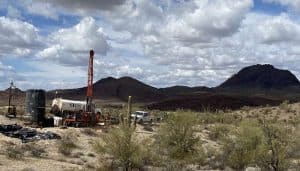
Lawrence Livermore National Laboratory (LLNL), Penn State (PSU) and University of Arizona (UA) researchers are partnering with industry collaborator Western Rare Earths (WRE), U.S. subsidiary of American Rare Earths Limited, to use a naturally occurring protein to extract and purify rare earth elements (REEs) from abundant, domestic ore-based feedstocks and waste materials without harming the environment. It could offer a new avenue toward a more diversified and sustainable REE sector for the United States.
Domestic sourced and processed REEs are essential for American competitiveness in the clean energy and high-tech industries. These rare earth and other critical minerals are used in many devices vital to a high-tech economy and national security, including computer components, high-power magnets, wind turbines, mobile phones, solar panels, superconductors, hybrid/electric vehicle batteries, LCD screens, night-vision goggles and solid oxide fuel cells (SOFCs). To date, the chemical processes used to extract, separate and purify REEs are harmful to the environment and not sustainable.
In the project, funded by the Department of Energy’s Critical Materials Institute, the researchers turned to the protein lanmodulin, which PSU’s Center for Critical Minerals team member Joseph Cotruvo discovered. This discovery enabled a one-step quantitative and selective extraction of REEs from electronic waste and pre-combustion coal—capabilities that other chemical extraction methods do not offer.
Through a collaborative effort between LLNL, PSU, UA and WRE, the team plans to develop a scalable, all-aqueous, protein-based method for high-purity recovery of the REEs scandium and yttrium from low-grade, abundant domestic allanite ore. Yttria-stabilized zirconia (YSZ) is the most widespread electrolyte material used for SOFCs, given its high ionic conductivity, electronic resistivity and stability over a wide temperature range. Scandia-stabilized zirconia (ScSZ) is an attractive alternative to the yttrium due to its higher conductivity and excellent stability, allowing lower operating temperatures and improved longevity. Scandium also is used in high-strength, lightweight aluminum–scandium alloys that offer fuel savings when used in aircraft and vehicles.
Currently, China produces the majority of REEs, including yttrium and scandium. “The absence of reliable, large-scale and long-term supply severely limits commercial applications of scandium,” said LLNL scientist Dan Park, principal investigator of the project. “We need to explore and exploit new sources and technologies to establish a domestic supply chain for scandium and yttrium for next-generation clean energy technologies.”
“The researchers affiliated with CMI, LLNL, UA and Penn State’s Center for Critical Minerals are the competitive advantage for the U.S. in its mission to responsibly secure this supply chain,” said Marty Weems, of Western Rare Earths and president, North America of American Rare Earths Limited. “The prospect of a sustainable, reusable, high-efficiency process that could extract, separate and purify scandium, yttrium and individual, high-value, rare-earth magnet metals could revolutionize the industry. The simplicity we see in the technology could bode well for scaling to industrial production. We are honored and humbled that CMI and the research team has chosen us as team member and will be using our Wyoming- and Arizona-sourced ultra-low thorium content feedstocks. This project is an excellent fit to our mission to resource the renewable future responsibly.”
A notable advantage of the allanite feedstock from WRE is the low level of uranium and thorium. These radioactive elements commonly co-occur in many other REE feedstocks and pose environmental and economic burdens due to their radioactivity. The team’s lanmodulin-based approach offers several unique advantages over the prior methods, including compatibility with low-grade leachates, elimination of harmful solvents and the ability to achieve high-purity separation of certain critical REEs.
The Critical Materials Institute is a DOE Energy Innovation Hub led by Ames Laboratory that seeks to accelerate innovative scientific and technological solutions to develop resilient and secure supply chains for rare-earth metals and other materials critical to the success of clean-energy technologies. The research team includes Park and Ziye Dong from LLNL, Cotruvo and Sarma Pisupati from Penn State, Hongyue Jin from the University of Arizona and Weems from Western Rare Earths.
